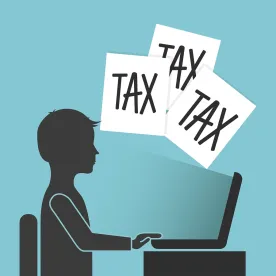The IRS recently published guidance on the new refundable employment tax credits available under the Families First Coronavirus Response Act (the “FFCRA”) and the Coronavirus Aid, Relief, and Economic Security Act (the “CARES Act”).
Both the FFCRA and the CARES Act provide refundable tax credits to employers for qualified wages paid to employees under circumstances stemming from the COVID-19 pandemic. Eligible employers can receive a refundable tax credit to cover all or some of the cost of mandatory qualified sick leave and qualified FMLA leave payments (collectively, “Qualified Leave Payments”).[1] In addition, under the CARES Act, employers whose operations are fully or partially suspended due to a COVID-19-related governmental order or who experience a greater than 50% reduction in quarterly receipts may receive a refundable tax credit equal to 50% percent of the first $10,000 in “qualified wages” paid to each employee (“Employee Retention Payments”).
New IRS Form 7200 Advance Payment of Employer Credits Due to COVID-19.
To aid cash-strapped employers in footing the up-front costs associated with Qualified Leave Payments and Employee Retention Payments, the IRS has established a procedure for employers to request an advance on refundable tax credits. The IRS stated that employers should first access federal employment taxes related to wages paid between April 1, 2020, and December 31, 2020, including withheld taxes, that would otherwise be required to be deposited with the IRS. Thus, the federal employment taxes that are available for the advance of the credits to pay for Qualified Leave Payments and Employee Retention Payments include withheld federal income tax, the employee share of Social Security and Medicare taxes, and the employer share of Social Security and Medicare taxes. According to recently published IRS Notice 2020-22, the IRS has waived penalties associated with the failure to deposit these amounts to the extent they are used to fund or reimburse the employer for Qualified Leave Payments and Employee Retention Payments. If these amounts are not sufficient to cover Qualified Leave Payments and Employee Retention Payments, the employer can file a Form 7200, Advance Payment of Employer Credits Due to COVID-19, to request a cash advance to cover such payments. Requests may be faxed to the IRS at the number listed in the instructions to the Form 7200.
When are business operations considered “partially suspended” to qualify for the Employee Retention Payments credit?
To qualify for the Employee Retention Payments credit, business operations must be fully or partially suspended due to a COVID-19 related governmental order during the quarter in question, or the employer must experience a greater than 50% reduction in quarterly receipts when compared to the employer’s quarterly receipts from the same quarter in the prior year. The IRS stated that business operations are considered partially suspended if COVID-19 related restrictions limit operations such that the business can still operate, but not at its normal capacity. For example, the IRS stated that a partial suspension occurs if a governmental ordinance mandates the closure of restaurants, but still permits the restaurant to sell food and/or beverages on a carry-out, drive-through or delivery basis.
Increase in Tax Credits for Employer’s Portion of Medicare Taxes and Health Plan Expenses Allocable to Qualified Leave Payments.
The tax credit for Qualified Leave Payments is increased by the employer’s portion of Medicare taxes paid on Qualified Leave Payments, as well as qualified health plan expenses allocable to Qualified Leave Payments (“Qualified Health Plan Expenses”). The IRS clarified that Qualified Health Plan Expenses generally includes employer contributions to a health plan on behalf on an employee, as well as employee contributions paid by pre-tax salary reductions. Qualified Health Plan Expenses generally excludes health plan expenses paid by the employee with after-tax contributions, or employer contributions to a health savings account. The IRS guidance provides examples that employers should find helpful in calculating the allocable Qualified Health Plan Expenses.
Determining Qualified Wages for the Employee Retention Payments Credit.
Eligible employers are entitled to the credit for “qualified wages” paid after March 12, 2020, and before January 1, 2021. The definition of “qualified wages” depends, in part, on the average number of full-time employees (as defined in section 4980H of the Internal Revenue Code) employed by the eligible employer during 2019.
If an eligible employer averaged more than 100 full-time employees in 2019, qualified wages are the wages paid to an employee for the time that the employee is not providing services during the economic hardship described above. As written, this would allow employers to claim the credit for a portion of the wages paid to employees who are working a reduced schedule but have not received a corresponding reduction in pay. For these employers, qualified wages taken into account for an employee may not exceed what the employee would have been paid for working an equivalent duration during the 30 days immediately preceding the period of suspension to business operations or economic hardship. Employers should be mindful of documenting the reduced work schedules, particularly in the case of salaried employees who might not otherwise document their working hours in the ordinary course of business.
If the eligible employer averaged 100 or fewer full-time employees in 2019, qualified wages are the wages paid to any employee during any period of suspension to business operations or economic hardship as described above.
The credit available to eligible employers is equal to 50 percent of the qualified wages (including allocable Qualified Health Plan Expenses calculated in a similar manner as described above) that eligible employers pay their employees after March 12, 2020, and before January 1, 2021. The maximum amount of qualified wages taken into account with respect to each employee for all calendar quarters is $10,000, so the maximum credit for an eligible employer for qualified wages paid to any given employee is $5,000.
An important distinction of allocable Qualified Health Plan Expenses with the Employee Retention Payments credit is that allocable Qualified Health Plan Expenses are included in the determination of qualified wages for each employee (and thus are counted towards the $10,000 maximum), in contrast to the allocable Qualified Health Plan Expenses for Qualified Leave Payments which are in addition to the maximum daily and aggregate limits on Qualified Leave Payments.
Denial of Double Credit for the Same Wages.
Employers can receive a 100% tax credit for Qualified Leave Payments under the FFCRA, and a 50% tax credit for Employee Retention Payments under the CARES Act. The IRS stated that an eligible employer cannot “double-dip” by claiming both tax credits for the same wages. An eligible employer may, however, receive a tax credit for Employee Retention Payments to the extent the wages are not eligible for a tax credit as Qualified Leave Payments, such as the case where the employer pays wages that do not constitute Qualified Leave Payments because the wages are in excess of applicable FFCRA tax credit caps.
Coordination with Payroll Tax Deferrals.
The CARES Act also allows employers to defer the employer portion of Social Security taxes. Fifty percent of the payment is deferred until December 31, 2021 and the remaining 50% is deferred until December 31, 2022. The deferral does not apply to federal income taxes, the employee portion of Social Security taxes nor to the employee and employer portions of Medicare taxes. The deferral also does not apply if the employer has had any loan forgiveness under the Paycheck Protection Program under the CARES Act. This ability to defer the employer portion of the Social Security taxes is in addition to the refundable tax credits discussed above. In fact, an employer is entitled to defer payment of the employer portion of Social Security taxes prior to knowing whether it is entitled to the refundable tax credits or the amount of such credits. But, such deferral would only be relevant to an employer receiving refundable tax credits to the extent such tax credits do not exceed the employer’s portion of Social Security taxes for the applicable period.
This article has been prepared by Sheppard, Mullin, Richter & Hampton LLP for informational purposes only and does not constitute advertising, a solicitation, or legal advice, and does not form an attorney client relationship. As you are aware, things are changing quickly and the aid measures and interpretations described here may change. This article represents our best understanding and interpretation based on where things currently stand.
Furthermore, the information provided herein does not constitute tax advice and may not be relied upon for avoidance of tax penalties or for any other purpose. Sheppard, Mullin, Richter & Hampton LLP expressly disclaims all liability in respect to actions taken or not taken based on the contents of this update.
[1] The per day and aggregate per employee maximum limits for Qualified Leave Payments are set forth in the IRS’ guidance titled “COVID-19-Related Tax Credits for Required Paid Leave Provided by Small and Midsize Businesses FAQs” found at the following link: https://www.irs.gov/newsroom/covid-19-related-tax-credits-for-required-paid-leave-provided-by-small-and-midsize-businesses-faqs.








 />i
/>i

